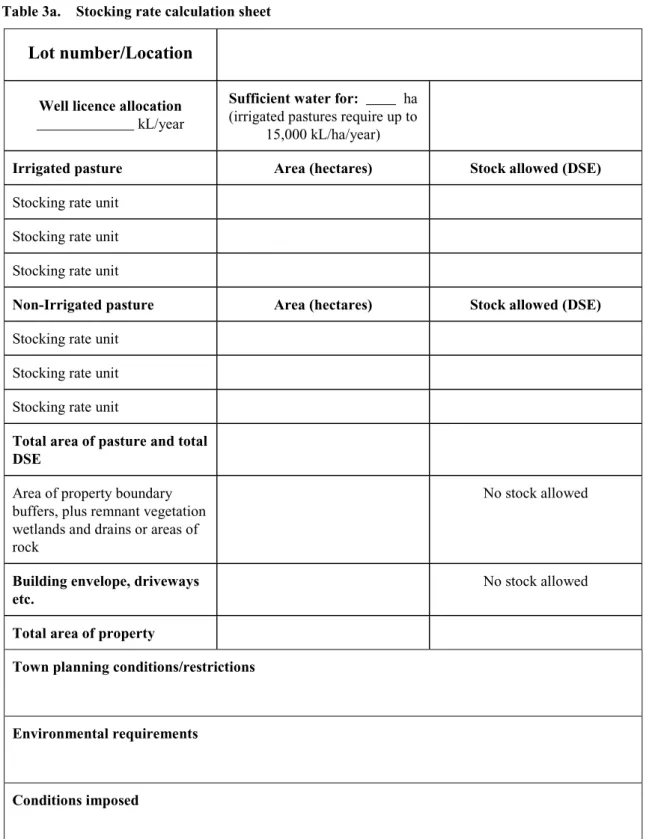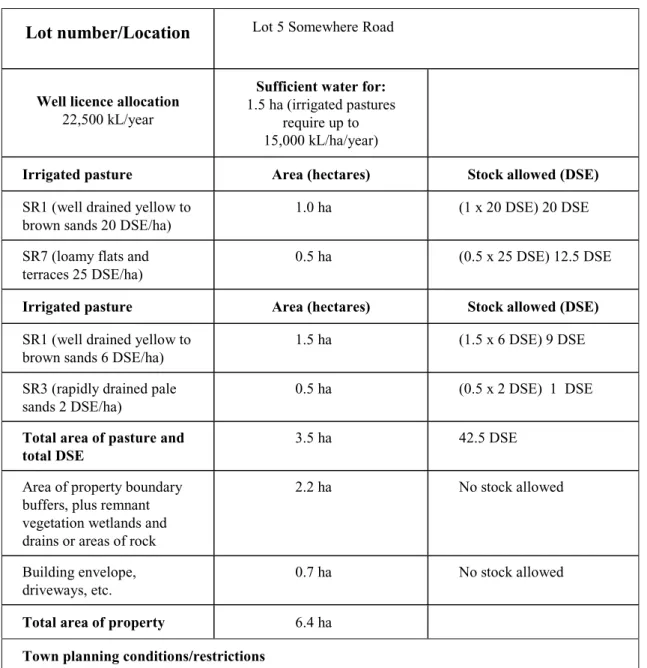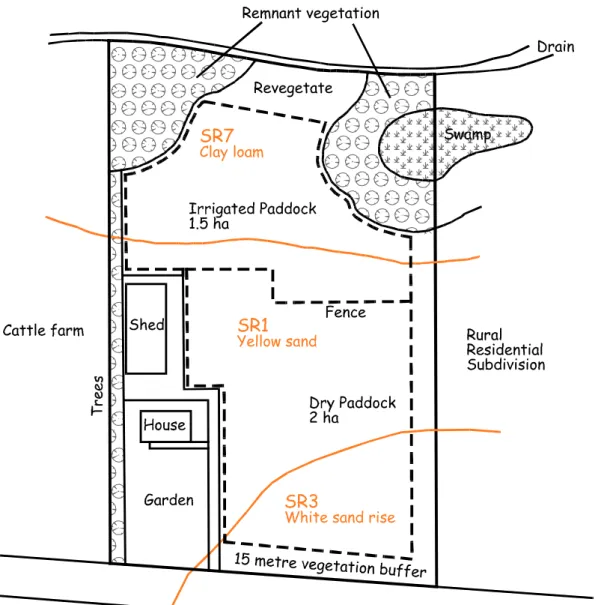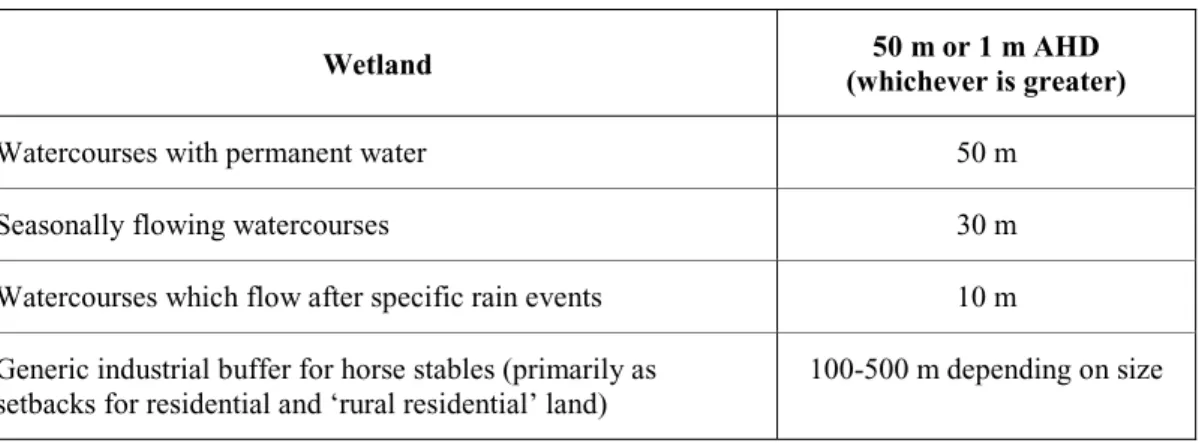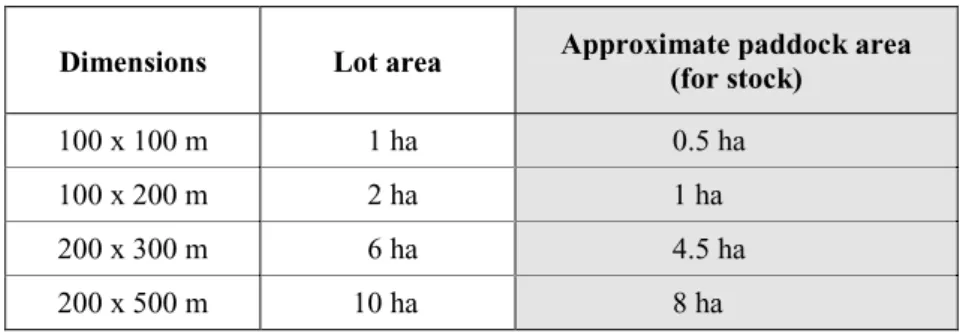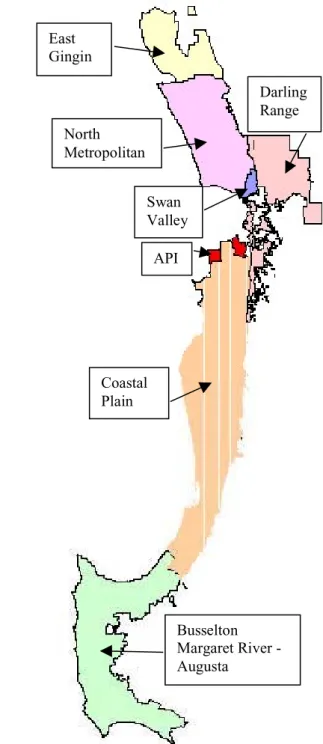The information in this publication has been compiled by Dennis van Gool and Ken Angell, Agriculture Western Australia and Lindsay Stephens of Landform Research. Stocking rates guidelines have been prepared for Agriculture Western Australia's Land Use Planning project managed by Ian Kininmonth. Peter Tille conducted a detailed review of the occupancy units and many of the survey-specific map unit assessments.
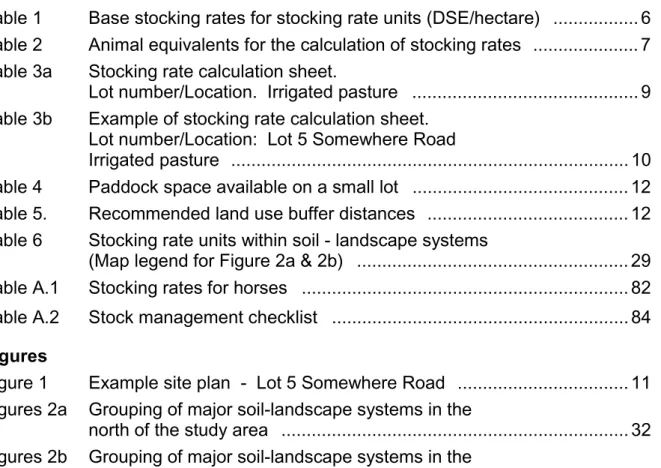
NEED FOR STOCKING RATE INFORMATION
Aims of the document
What is a rural small holding?
Small rural holdings are usually used for recreational or lifestyle purposes, but sometimes include intensive farms, such as orchards or vineyards, organic production, or specialty livestock such as emus or alpacas. Apart from historically unplanned or de facto "rural residential areas", planned uses for small farms vary. Another major use of small lots in the countryside is for keeping stock, especially horses.
Stock on the Swan Coastal Plain and surrounding areas
The most common lot size is 1 to 2 hectares, but small rural holdings can range from 0.5 to 40 hectares or more. An example is the rural green areas identified in the Inner Peel Structure Plan (WAPC 1996). A number of underground protection areas have also been identified which limit a wide range of land uses and may affect uses for pasture irrigation or activities such as horticulture.
STOCKING RATES
- What are stocking rates?
- The base stocking rate
- Stocking rate units
- Animal equivalents
To simplify the calculation of the occupancy rate, the soil-landscape information for the Swan Coastal Plain and Darling Scarp has been divided into 10 occupancy rate units with similar soils and similar management requirements. The land units of the occupancy rate provide a broad overview of similar soils and landscapes on the Coastal Plain. In many cases, however, this information and some knowledge of the property's location will be sufficient to determine the base occupancy rate.
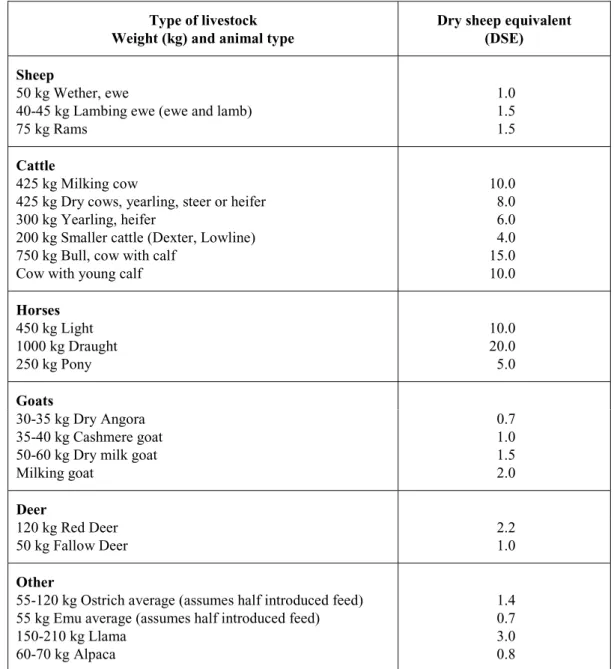
Applying stocking rates to a property
Some recommended land use buffer distances
Streams that flow after specific rain events 10 m Generic industrial buffer for horse stables (primarily as. In addition to setbacks for horse stables, no other setbacks are provided for low-intensity grazing purposes, however, separation distances are recommended in rural residential areas to minimize potential for land use conflict due to dust and odors.
Fencing
For example, deer require a strong fence of at least 2 m with a small mesh size of 100 mm by 100 mm near the base to prevent escape of young calves or entry of predators. Electric fencing is excellent for controlling most types of stock and can be used in conjunction with a variety of different fences on property boundaries. The main drawback of electric fencing is that it must have a reliable power supply and requires constant monitoring to ensure it remains effective.
STOCKING RATE UNITS
Residual vegetation may contain poorly preserved plant communities at the base of the Darling Scarp. In areas of the coastal plain, such as in the foothills, it is common to find small amounts of ferruginous gravels deeper in the profile. Smaller areas are also associated with some smaller streams and in very limited areas along some coastal lakes within the Vasse system.
SOIL – LANDSCAPE SYSTEMS AND STOCKING RATE UNITS
Dunes and flats on limestone, with deep yellow sand, deep pale sand and shallow yellow/brown sand. Tuart forest and forest on the Swan Coastal Plain, mari-jarrah-karri forest, coastal forest and heath south of Cape Naturaliste. Dunes, flats and swampy depressions of the Swan Coastal Plain, with deep pale sands and semi-humid soils predominating.
Banksia woodland and heather on dunes and flats and paperbark woodland on wetter flats and depressions. Duplex soils with deep gray sand, loamy soils, fissile clays, often with self-mulching surfaces, extensive areas of saline and moist non-saline soils. Wide U-shaped valleys 80-150 m deep, smaller V-shaped valleys east of the Gingin Scarp in the south.
Undulating terrain with remains of lateritic plateaus, with sandy gravels, deep sands, semi-moist soils. Deep valleys, in flat areas, with loamy soil, loamy duplexes, loamy and sandy gravels, stony soils and sandy duplexes.
SOIL – LANDSCAPE MAP UNITS FROM MEDIUM SCALE LAND
Land qualities considered in the assessment of stocking rates
Swan Coastal Plain soil-landscape survey
Swan Valley soil-landscape survey
West Gingin soil-landscape survey soils only
Northern metropolitan soil-landscape survey
Busselton-Margaret River-Augusta Land Capability Study
Darling Range soil-landscape survey
ADDITIONAL INFORMATION AND REFERENCES
- Land Management information ordered by land management issue
- Agriculture Western Australia land resource information
- Other land resource survey references
- Further reading
- Technical publications and references
General guides for small rural holdings include: The Small Block Manual (prepared by Mortlock W, 1994 for the Shire of Serpentine-Jarrahdale) and The Land is in your hands - a practical guide for smallholders in rural Western Australia (Agriculture Western Australia, 1999) . Agricultural Notes (F/N), Technical Notes (T/N), Bulletins (B/N) and Miscellaneous Publications (M/P) and many brochures are also available from Agriculture Western Australia. Land Clearance F/N 34/99 Regulation 4 Governing Land Clearance Mortlock, W. Erosion Control F/N 43/99 Windbreaks for Horticulture on the Swan Coastal Plain M/P 23/97 Prevention of Soil Erosion and Deterioration of Soil Structure -A. a guide to soil management practices for gardeners in high-rainfall SW hills.
F/N 8/91 Land use and general property management F/N 17/86 Development guidelines for small rural parcels F/N 19/86 Area assessments for small rural parcel developments Western Agriculture. Soil Resources from Harvey to Capel on the Swan Coastal Plain, Two Maps, Agriculture Western Australia. Land resources of the northern and southern sections of the Peel-Harvey Catchment, Two Maps, Agriculture Australia Western.
These published reports are not produced by Agriculture Western Australia, but may come from libraries or Agriculture Western Australia. Computer generated printouts of the maps or digital copies of the maps are available from Agriculture Western Australia. Landforms and soils as an aid to urban planning in the metropolitan northwest corridor of Perth, Western Australia.
A comparison of nutrient inputs from existing and proposed land use on the 'Chestnuts' estate in Jarrahdale.
Stocking rates for horses
Note: For stocking rates exceeding those recommended for dry pasture and dry pasture with supplemental feed, a pasture and nutrient management plan may be required depending on the stocking rate unit and site conditions. A stock management plan should be prepared when a property that exceeds the recommended basic stock rates is accumulated. This checklist can be useful for all landowners, it is important for those applying to the relevant authorities to reserve their land above the basic stock rate.
This exceeds the base occupancy rate and will normally require approval from the local government. Stocking may be permitted at the base stocking rate determined by Agriculture Western Australia guidelines. Preventing Soil Erosion and Tree Damage on Small Holdings' and the publication 'Stocking Rate Guidelines for Small Rural Holdings' (in Prep) which updates these standards for the Swan Coastal Plain and Darling Scarp.
Farm Note 52/89 'Prevention of Soil Erosion and Tree Damage on Smallholdings' and publication 'Stocking Rate Guidelines for Small Farms' (in preparation). Western Australian Agricultural Standards for stock levels applicable to rural residential and other non-agricultural/rural areas. Local authorities are responsible for advising landowners in rural residential and other non-agricultural areas on stock levels in accordance with the guidelines.
Where a landowner applies to stock their land at a rate in excess of the recommended rate, it is recommended that they prepare a management plan (see 'Stocking rate guidelines for small rural holdings').
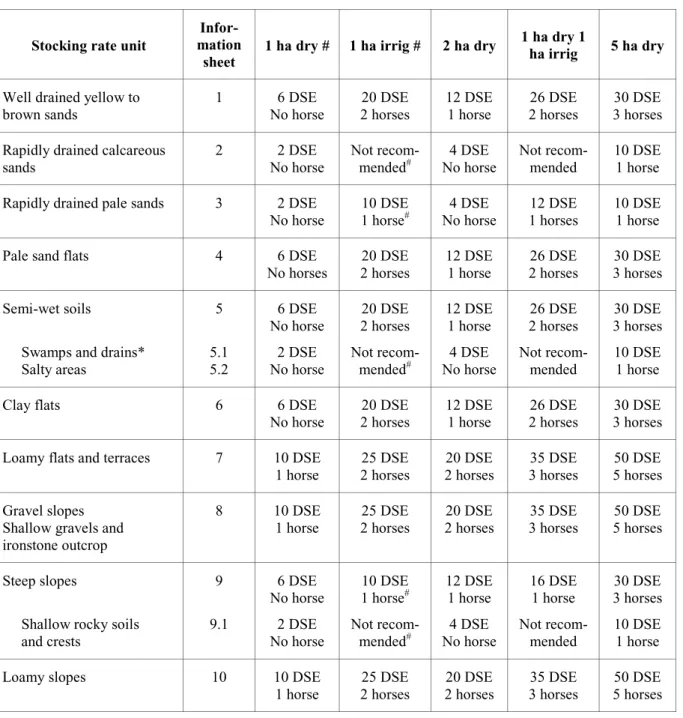
Increasing stocking rates
Additional notes for planners and developers
The ability of soil to accept stock depends on many factors, including soil permeability, depth to the water table, ability of the soil to hold phosphate, potential for erosion and waterlogging, as well as how the soils are managed and the need for adequate vegetation. retain. . Even though nutrient loss is a major concern on the Coastal Plain, pasture improvement requires fertilizer applications. Stocking rate should be determined at the time of subdivision design, taking into account soils and all other environmental and social factors.
The stock rate can be recorded for each lot as a DSE value to allow buyers to select the block that allows them to hold their planned stock. Low accumulation rates of dry washed sand (e.g. SR2 and SR3 stock rate units) may exclude horses from a 2 hectare area even with irrigation, unless animals are stabilized and maintained on fed feed . Some planning schemes have minimum lot sizes in which stock can be held or specify the maximum amount of stock that can be held.
Shire approval must be required before holding stock above base rate. Large livestock, such as horses or cattle, may only be kept if a treatment facility such as a yard, stable or restraint is available. Improved grassland should be managed to minimize nutrient loss at a rate that does not exceed guidelines set by Water and Rivers.
Where, in the opinion of the local authority, the continued presence of animals on any part of the land is likely to contribute, or contribute to unsatisfactory environmental impacts, the owner of the land may be issued a notice requiring that the animals be kept for a specified period of time. be removed. period and carrying out repairs.
Agriculture Western Australia
A policy to ensure that land holdings in rural areas, special rural areas, special residential areas and other non-agricultural zones are stockpiled at levels unlikely to result in land degradation and other negative environmental impacts. Small rural holdings contained in rural areas, special rural areas, special residential areas and other non-agricultural zones are often owned by people who wish to pursue a rural lifestyle but are inexperienced in land management matters. Rural development, special rural areas, special residential areas and other non-agricultural/rural zones are considered to be alternative forms of housing.
As such, local authorities are considered to be responsible for ensuring and enforcing the responsible management of land resources in these areas. In some cases, local planning will state that the stocking density must not exceed Agriculture Western Australia's standards. Agriculture Western Australia will encourage the use of land use planning processes to ensure that land in rural residential areas is not stockpiled beyond its environmental carrying capacity.
Local governments will be encouraged to implement strategies to ensure that landowners are aware of their obligations regarding animal husbandry and land resource management. This management plan should be reviewed by the local government environmental officer or other qualified person. If land storage in a rural residential area or other non-agricultural/rural areas causes or is likely to cause unsatisfactory environmental impacts, then that is local.
Agriculture Western Australia will provide specific advice on land management and remediation to small rural farmers for a fee for service.
